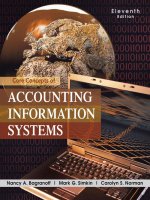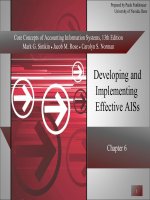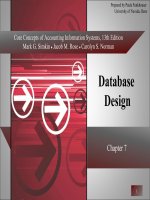Core concepts of accounting information systems 13 by simkin norman chapter 06
Bạn đang xem bản rút gọn của tài liệu. Xem và tải ngay bản đầy đủ của tài liệu tại đây (784.08 KB, 48 trang )
Prepared by Paula Funkhouser
University of Nevada, Reno
Core Concepts of Accounting Information Systems, 13th Edition
Mark G. Simkin ● Jacob M. Rose ● Carolyn S. Norman
Developing and
Implementing
Effective AISs
Chapter 6
1
Chapter 6: Developing and Implementing
Effective AISs
• Introduction
• System Development Life Cycle
• Systems Planning
• Systems Analysis
• Detailed Systems Design and Acquisition
• Implementation, Follow-Up, and Maintenance
2
Copyright © 2015. John Wiley & Sons, Inc. All rights reserved.
Introduction
• Collaboration
–
Users, Analysts, Designers, Managers, Accountants and Auditors
• Study of IT Systems
–
Planning and analysis through development
–
Design, Development, and Implementation
–
Maintenance of AIS applications
3
Copyright © 2015. John Wiley & Sons, Inc. All rights reserved.
Systems Development
Life Cycle
• Systems Study
–
Systems development work
–
Formal investigation of an existing information system
• Performance of Study
–
In-house professionals (large organizations)
–
Hire outside consultants (smaller companies)
4
Copyright © 2015. John Wiley & Sons, Inc. All rights reserved.
Four Stages in the Systems
Development Life Cycle
• Planning and Investigation
–
Organize a systems study team
–
Preliminary investigation of current system
–
Develop strategic plans
• Analysis of Current System
–
Identify information needs
–
Strengths and weaknesses
5
Copyright © 2015. John Wiley & Sons, Inc. All rights reserved.
Four Stages in the Systems
Development Life Cycle
• Design
–
Changes that eliminate/minimize weak points
–
Preserve the strengths
• Implementation, Follow-up, and Maintenance
–
Resource acquisition
–
Training employees
–
Follow-up studies
–
Identify new problems and correct
6
Copyright © 2015. John Wiley & Sons, Inc. All rights reserved.
Systems Development
Life Cycle
7
Copyright © 2015. John Wiley & Sons, Inc. All rights reserved.
Systems Studies and AISs
• Applications Portfolio
– Enterprise resource planning (ERP)
•
•
•
•
•
Work flows
Data Gathering
Recording tasks
Employee responsibilities
Rewarding managers
– Business process reengineering (BPR)
• Employee resistance
8
Copyright © 2015. John Wiley & Sons, Inc. All rights reserved.
Study Break #1
Which one of the four stages in the Systems Development Life
Cycle is likely to be most costly for a new system?
A. Planning and Investigation
B. Analysis
C. Design
D. Implementation, Follow-up, and Maintenance
9
Copyright © 2015. John Wiley & Sons, Inc. All rights reserved.
Systems Planning
• Planning for Success
– Broad viewpoint in a systems study
– Use an interdisciplinary study team for evaluation of
systems
– Study team works closely with steering committee
– Align study with mission and strategic goals and
objectives
10
Copyright © 2015. John Wiley & Sons, Inc. All rights reserved.
Systems Planning
• The Study Team and the Steering Committee
– Interdisciplinary study team
– Communicate closely with management
– Appoint a steering committee
• Investigating Current Systems
– Preliminary investigation to identify issues
– Consider alternatives
– Make recommendations
11
Copyright © 2015. John Wiley & Sons, Inc. All rights reserved.
Systems Analysis
• Purpose
–
–
–
–
Become familiar with current system
Identify inputs and outputs
Identify strengths and weaknesses
Make recommendations
• Study Team Activities
– Identify and understand system goals
– Perform a systems survey
– Report findings
12
Copyright © 2015. John Wiley & Sons, Inc. All rights reserved.
Systems Analysis Procedures
13
Copyright © 2015. John Wiley & Sons, Inc. All rights reserved.
Understanding Organizational
Goals
• General Systems Goals
–
Benefits should exceed the costs
–
Create output that helps make better decisions
–
Allows for optimal access to information
–
Accommodates changing information needs
14
Copyright © 2015. John Wiley & Sons, Inc. All rights reserved.
Understanding Organizational
Goals
• Top Management Systems Goals
–
Long-range budget planning data
–
Periodic performance reports
–
Short-range operating performance
• Operating Management Systems Goals
–
Well-defined narrow organization areas
–
Current year decisions
15
Copyright © 2015. John Wiley & Sons, Inc. All rights reserved.
Systems Survey Work
• Systems Survey
–
Allows for a more complete understanding
–
Strengths and weaknesses of current system
• Understanding the Human Element and Potential Behavioral
Problems
–
Employee resistance to change
–
Gain full cooperation and support
16
Copyright © 2015. John Wiley & Sons, Inc. All rights reserved.
Systems Survey Work
• Data Gathering
–
Review existing documentation or create new materials
–
Observe the current system in operation
–
Use questionnaires and surveys
–
Review internal control procedures
–
Interview systems participants
17
Copyright © 2015. John Wiley & Sons, Inc. All rights reserved.
Systems Survey Questionnaire
18
Copyright © 2015. John Wiley & Sons, Inc. All rights reserved.
Data Analysis
• Components
– Create summary statistics
– Systems documentation
• Time Period
– Longer than preliminary investigation
– May provide interim reports
• Conclusions
– Final systems analysis report
– Submit to steering committee
Copyright © 2015. John Wiley & Sons, Inc. All rights reserved.
19
Evaluating System Feasibility
• Technical Feasibility
–
Required technical resources
–
Hardware and software
–
Technical skills of current employees
• Operational Feasibility
–
Compatibility with current environment
–
Capabilities of current employees
20
Copyright © 2015. John Wiley & Sons, Inc. All rights reserved.
Evaluating System Feasibility
• Schedule Feasibility
–
Estimate time needed for implementation
• Legal Feasibility
–
Conflicts between system and legal obligations
• Economic Feasibility
–
Cost-benefit analysis
–
Difficulties estimating implementation costs
21
Copyright © 2015. John Wiley & Sons, Inc. All rights reserved.
Study Break #2
The feasibility evaluation:
A. Is completed prior to detailed systems design
B. Includes economic, schedule, technical, legal, and
operational feasibility
C. Both a and b are true
D. Neither a nor b is true
22
Copyright © 2015. John Wiley & Sons, Inc. All rights reserved.
Study Break #3
In developing an implementing IT, the study team and steering
committee must consider organizational goals. These include:
A. General, technical, and top management goals
B. General, operating management, and technical goals
C. Top management, operating management, and economic
goals
D. Top management, operating management, and general
systems goals
23
Copyright © 2015. John Wiley & Sons, Inc. All rights reserved.
Detailed Systems Design
• Designing System Outputs, Processes and Inputs
• Prototyping
• The Systems Specifications Report
• Choosing an Accounting Information System
• Outsourcing
24
Copyright © 2015. John Wiley & Sons, Inc. All rights reserved.
Steps in the Systems Design Phase
25
Copyright © 2015. John Wiley & Sons, Inc. All rights reserved.









